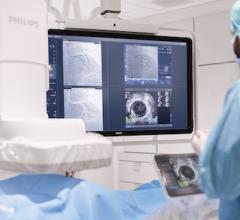December 27, 2011 — The January 2012 issue of the Journal of the American Society of Echocardiography (JASE) will feature a new resource for guidance on three-dimensional echocardiography (3-DE). The document, titled The EAE/ASE Recommendations for Image Acquisition and Display Using Three-Dimensional Echocardiography, provides a practical guide on how to acquire analyze and display the various cardiac structures using 3-DE.
The paper also discusses limitations of the technique, as well as current and potential clinical applications of 3-DE and its strengths and weaknesses in those scenarios.
This technique is gaining appreciation in the medical field, as it can be of benefit to patients with valvular heart disease and to more accurately quantify chamber dimension and function. A full understanding of the technical principles of 3-DE, and a systematic approach to image acquisition, display and analysis, is essential to support its integration into routine clinical practice.
The usefulness of 3-DE has been demonstrated in: (a) the evaluation of cardiac chamber volumes and mass, which avoids geometric assumptions;(b) the assessment of regional left ventricular wall motion and quantification of systolic dyssynchrony; (c) presentation of realistic views of heart valves; (d) volumetric evaluation of regurgitant lesions and shunts with 3-DE color Doppler imaging; and (e) 3-DE stress imaging.
ASE Past President Roberto M. Lang, M.D., FASE, professor of medicine and radiology and director of the cardiac imaging center at the University of Chicago Medical Center, lead author of the document, explains: “While 3-D TTE currently complements routine 2-D in daily clinical practice by providing additional volumetric information, its full complementary potential has not yet been exploited. ASE has provided a practical technical operation document for 3-D TTE and TEE with current standard echocardiography systems and on-cart software.” He adds, “While the details will become obsolete with future systems, those who have started with clinical 3-DE and developed a full understanding of basic terminology should be able to easily follow future evolution of the technique.”
It is important that 3-D images be displayed in uniform manner to facilitate interpretation and comparisons between studies. Lang notes, “In near future, the ability to acquire a single-heartbeat full-volume data set with higher temporal and spatial resolution, and live 3-D color Doppler imaging with a larger angle, should be feasible. All of these will continue to enhance 3-D utility and efficiency in daily clinical practice.”
The January 2012 issue of JASE also includes a number of articles that explore novel applications of 3-DE and further illustrate its clinical relevance. JASE Editor-in-Chief Alan S. Pearlman, M.D., FASE, professor of medicine and director of the echocardiography laboratory at the University of Washington Medical Center, notes: “I believe that real-time volumetric imaging using 3-D echocardiography now provides a practical way to measure ventricular volumes and ejection fraction without making any assumptions about chamber geometry, and suspect that one day this imaging method will surpass current 2-D echo imaging, just as 25 years ago 2-D imaging supplanted M-mode echocardiography. Moreover, it is increasingly clear that 3-D echo provides unique views in patients with valvular and congenital heart disorders, and I believe that the clinical use of this technique is likely to grow rapidly.”
ASE will provide additional education related to this guideline at its annual scientific session in National Harbor, Md., June 29-July 3. Sessions include 3-D: What Does it Add on June 30, and The Added Value of 3-D Echocardiography: An ASE/EAE Consensus on July 1.
For more information: www.asecho.org


 December 23, 2025
December 23, 2025 









